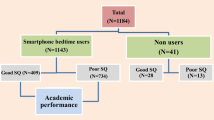Abstract
The aim of the study was to examine the relationship between sleep problems and objective driving behaviors of short-haul commercial truck drivers in Japan. One hundred and ten male short-haul commercial truck drivers’ sleep duration, sleep quality (Pittsburgh Sleep Quality Index), and frequency of sleepiness at the wheel were measured by survey in June 2019. In addition, their dangerous driving behaviors (i.e., overspeeding, sudden start and acceleration, sudden deceleration, and sudden braking) during June were calculated using digital tachograph data. Logistic regression analysis (LRA) was performed. The dependent variables were the presence/absence of dangerous driving behaviors, and sleep duration, sleep quality, and sleepiness were assigned as independent variables. Body mass index was adjusted as a confounding variable. LRA for sleep duration revealed that the “<5 h group” was associated with tendency of a higher adjusted odds ratio (2.87, 95% confidence interval = 0.87–9.45, p = 0.08) for sudden braking compared with the “6 h group.” LRA for sleep quality revealed that the “poor quality group” was associated with a higher adjusted OR (2.56, 95% CI = 1.09–6.01) for sudden braking compared with the “normal quality group.” LRA for the frequency of sleepiness revealed that the “frequently group” was associated with a higher adjusted OR (5.15, 95% CI = 1.10–24.13) for sudden braking compared with the “never group.” Nevertheless, sleep problems were nonsignificantly associated with other dangerous driving behaviors. Truck drivers with poor sleep quality and/or frequent sleepiness at the wheel displayed a 2.5–5.1 times greater risk of sudden braking than did drivers without these sleep problems.
Similar content being viewed by others
References
Ministry of Land, Infrastructure, Transport and Tourism, Japan. Transportation statistics (Japanese). 2020 [updated 2020; cited 2020 August]; Available from: https://www.mlit.go.jp/k-toukei/saishintoukeihyou.html
Ministry of Health, Labour and Welfare, Japan. The status of occurrence of industrial injuries in 2019 (Japanese). 2020 [updated 2020; cited 2020 August]; Available from: https://www.mhlw.go.jp/bunya/roudoukijun/anzeneisei11/rousai-hassei/
Horne J, Reyner L. Vehicle accidents related to sleep: a review. Occup Environ Med. 1999;56:289–94.
Bioulac S, Micoulaud-Franchi JA, Arnaud M, Sagaspe P, Moore N, Salvo F, et al. Risk of motor vehicle accidents related to sleepiness at the wheel: a systematic review and meta-analysis. Sleep. 2017;40:zsx134.
Inoue Y, Komada Y. Sleep loss, sleep disorders and driving accidents. Sleep Biol Rhythms. 2014;12:96–105.
Horne JA, Reyner LA. Sleep related vehicle accidents. BMJ. 1995;310:565–7.
Garbarino S, Durando P, Guglielmi O, Dini G, Bersi F, Fornarino S, et al. Sleep apnea, sleep debt and daytime sleepiness are independently associated with road accidents A cross-sectional study on truck drivers. PloS One. 2016;11:e0166262.
Yamauchi T, Sasaki T, Takahashi K, Umezaki S, Takahashi M, Yoshikawa T, et al. Long working hours, sleep-related problems, and near-misses/injuries in industrial settings using a nationally representative sample of workers in Japan. PLoS One. 2019;14:e0219657.
Anderson NJ, Smith CK, Byrd JL. Work-related injury factors and safety climate perception in truck drivers. Am J Ind Med. 2017;60:711–23.
Chen GX, Fang Y, Guo F, Hanowski RJ. The influence of daily sleep patterns of commercial truck drivers on driving performance. Accident Anal Prev. 2016;91:55–63.
Zhou T, Zhang J. Analysis of commercial truck drivers’ potentially dangerous driving behaviors based on 11-month digital tachograph data and multilevel modeling approach. Accident Anal Prev. 2019;132:105256.
Doi Y, Minowa M, Uchiyama M, Okawa M, Kim K, Shibui K, et al. Psychometric assessment of subjective sleep quality using the Japanese version of the Pittsburgh Sleep Quality Index (PSQI-J) in psychiatric disordered and control subjects. Psychiatry Res. 2000;97:165–72.
Ministry of Land, Infrastructure, Transport and Tourism, Japan. Implementation manual of general guidance and supervision by a road haulage business operator to drivers of commercial vehicle (Japanese). 2012 [updated 2012; cited 2020 August]. Available from:https://www.mlit.go.jp/jidosha/anzen/03safety/resourse/data/truck_honpen.pdf .
Philip P, Sagaspe P, Moore N, Taillard J, Charles A, Guilleminault C, et al. Fatigue, sleep restriction and driving performance. Accident Anal Prev. 2005;37:473–8.
Pack AI, Maislin G, Staley B, Pack FM, Rogers WC, George CF, et al. Impaired performance in commercial drivers: role of sleep apnea and short sleep duration. Am J Respir Crit Care Med. 2006;174:446–54.
Lemke MK, Apostolopoulos Y, Hege A, Sönmez S, Wideman L. Understanding the role of sleep quality and sleep duration in commercial driving safety. Accident Anal Prev. 2016;97:79–86.
Mitler MM, Miller JC, Lipsitz JJ, Walsh JK, Wylie CD. The sleep of long-haul truck drivers. N Engl J Med. 1997;337:755–61.
Reyner LA, Horne JA. Falling asleep whilst driving: are drivers aware of prior sleepiness? Int J Legal Med. 1998;111:120–3.
Traffic Bureau, National Police Agency, Japan. Statistics about road traffic: Ttraffic accidents situation. 2020 [updated 2020; cited 2020 August]; Available from: https://www.e-stat.go.jp/en/stat-search/files?page=1&layout=datalist&toukei=00130002&tstat=000001027458&cycle=7&year=20190&month=0
Ministry of Land, Infrastructure, Transport and Tourism, Japan. Motor Truck Transportation Business Transport safety rules (Japanese). 2019 [updated 2019; cited 2020 August]; Available from: https://elaws.e-gov.go.jp/search/elawsSearch/elaws_search/lsg0500/detail?lawId=402M50000800022
Philip P, Chaufton C, Orriols L, Lagarde E, Amoros E, Laumon B, et al. Complaints of poor sleep and risk of traffic accidents: a population-based case-control study. PLoS One. 2014;9:e114102.
Acknowledgments
This study was supported by the JNIOSH project research (N-P30-01).
Author information
Authors and Affiliations
Corresponding author
Ethics declarations
Conflict of interest
The authors declare no conflicts of interest.
Ethical committee permission
The study was approved by the Research Ethics Committee of the National Institute of Occupational Safety and Health, Japan (H3024).
Informed consent
All participants gave informed consent.
Additional information
Publisher's Note
Springer Nature remains neutral with regard to jurisdictional claims in published maps and institutional affiliations.
Rights and permissions
About this article
Cite this article
Ikeda, H., Matsumoto, S., Kubo, T. et al. Relationship between sleep problems and dangerous driving behaviors in Japanese short-haul commercial truck drivers: a cross-sectional survey using digital tachograph data. Sleep Biol. Rhythms 19, 297–303 (2021). https://doi.org/10.1007/s41105-021-00318-9
Received:
Accepted:
Published:
Issue Date:
DOI: https://doi.org/10.1007/s41105-021-00318-9



